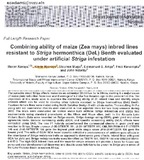Combing ability of maize (Zea Mays) inbred lines resistant to striga hermonthica (Del.) Benth evaluated under artificial striga infestation

View/
Date
2014-04-17Author
Karaya, Haron
Kiarie, Njoroge
Mugo, Stephen
Aringa, Emmanuel S.
Nderitu, John
Kanampiu, Fred
Type
ArticleLanguage
enMetadata
Show full item recordAbstract
The parasitic weed Striga affects maize on an estimated 20 million ha in Africa, making it a major cause of maize yield reduction from near world average of 4.2t/ha few decades ago to the present 1.5 t/ha. The objectives of this study were to examine the combining ability of 20 inbred lines and identify single crosses which can be used to develop other hybrids resistant to Striga hermonthica (Del.) Benth. Fourteen female lines were mated using North Carolina Design II with all six males. The resulting 84 F1S along with six commercial checks were evaluated in four separate trials for two rainy seasons during 2010. The trials were conducted on station under both artificial Striga infestation and Striga free environment s using standard procedures at the Kibos and Alupe sites, both in the Kenya’s Lake Victoria Basin. Data were recorded on Striga counts, Striga damage rating (SDR), grain yield and other agronomic traits. General combining ability (GCA) specific combining ability (SCA) effects were computed using SAS. The new F1 haybrids outperformed the commercial checks in grain yield and reaction to Striga. Single crosses JI-30-3/TESTR 151, JI-3-18/TESTR 151, CML206//56/44-6-3-7-1/TESTR 149 and JI-30-18/TESTR 156 gave the highest yield while single cross JI10-28-/TESTR 136 gave the lowest yield. The ratio of GCA: SCA mean squares exhibited a predominance of additive gene affects in the inheritance of Striga resistance traits as opposed to dominance gene effects. Inbred lines with good GCA for yield and Striga resistance traits were identified as TESTR 151, TESTR 156 and OSU231//56/44-6-4-17-3. The high GCA inbred lines and the superior single crosses will provide a basis for future use per se and also development of three-way and double cross hybrids to be grown in Striga prone areas of the Lake Victoria Basin in Eastern Africa.
Citation
African Journal of Agricultural researchSponsorhip
University of NairobiPublisher
University of Nairobi, Faculty of Agriculture
